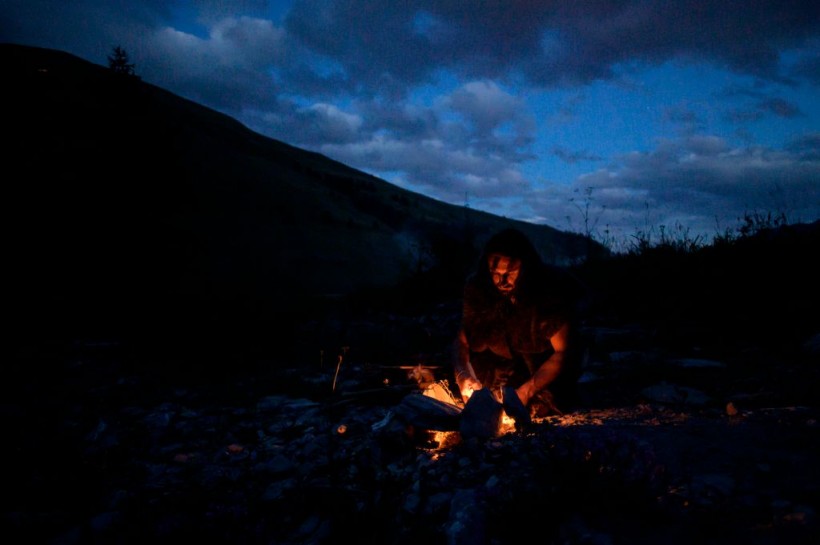Experts from Leiden University and other collaborators conducted a new archaeological study about the human ancestors. According to the research, the early humans who pursued hunt-gathering throughout the planet were responsible for the significant changes of the ancient ecosystems 125,000 years ago.
The ancestors investigated in the study were the Neanderthals, who were among the first humans to create and utilize fire for various purposes. The investigation theorized that the Neanderthals took advantage of the fire's properties to maintain and develop their habitat's landscapes suitable for the population.
Neanderthals Reshaped Ecosystems

TOPSHOT - Guido Camia dressed as a Neanderthal Caveman light a campfire in Chianale, in the Italian Alps, near the French border, on August 7, 2019. - Camia, a former pastry chef, is an expert in survival techniques and a master in several martial arts. He organizes with his association "Adventure Experience" survival courses inspired by Neanderthals life in the woods of the Alps region all over the year.
Leiden University's Faculty of Archaeology expert and author of the study Wil Roebroeks said in a PhysOrg report that throughout the history of archaeological studies, scientists speculated how the human ancestors were able to modify the untapped ecosystems of the planet, as well as the scale of each of the human intervention approaches they imprinted to the environment.
The artifacts that the authors unearthed back in an archaeological spot in Europe were among the substantial pieces of evidence to support the theories. The place rich in the clues of ancient human-induced developments was the lignite quarry of Neumark-Nord, located in the town of Halle in Germany. The previous decades of archaeological studies considered the site a subject for clues on early human activities, perspectives of the ancient environment, and the Neanderthal lineage.
Roebroeks said in the report that aside from the pieces of evidence their team was looking for, there were other artifacts and remains buried at the site. The specimens scattered across the Neumark-Nord lignite quarry were disintegrated parts of slaughtered animals, used charcoals, as well as ancient stone tools.
The data collected from the samples in Germany revealed that about 125,000 years ago, a vast forest had covered the region between Netherlands and Poland. The biodiversity was abundant in the landscape, which housed various animals such as hyenas, elephants, and even lions. The forest also included several water bodies such as lakes. According to the authors, many of the Neanderthal traces were excavated near the edges of the ancient jungle. And to cultivate a small part of the ecosystem, the early humans decided to sculpt some areas according to their liking. The method they have used the most is burning the bits of the first by fire.
ALSO READ: Vikings: High-Energy Cosmic Rays Confirms Viking Legends in Recent Study
Early Humans Modifying Ancient Environments Still a Debate
Leiden University's paleobotany expert Corrie Bakels conducted separate research expected to contribute to Roebroeks' research. Based on this independent study, several lakes in the forest were also examined. On the other hand, these lakes did not contain any traces of the Neanderthals, even though the same animals roamed throughout the areas.
For about 2,000 years before Roebroeks' timeline, Bakels explained that the Neanderthal settlements along the forest were already open. With that said, the question of whether the change in landscape or the arrival of the early humans came first remains unsolved.
The clues gathered from the past archaeological studies still consider that humans could not perfect agriculture until 10,000 years ago. It included the development of fields and cutting trees. But recent theories agree that there might have been human interventions that took place much earlier than we first thought.
Roebroeks believe that early humans were not just simply 'primal hippies' that hunt-gathered for resources for consummation. But also responsible for remodeling ancient landscapes. The study was published in the journal Science Advances, titled "Landscape modification by Last Interglacial Neanderthals."
RELATED ARTICLE: Archeology: Ancient Humans Farmed Vicious Cassowaries, Thousands of Years Before Raising Chickens
Check out more news and information on Archaeology in Science Times.



![Earth's Quasi-Moon Kamo‘oalewa Could Originate From Lunar Surface Not Asteroid Belt [Study]](https://1721181113.rsc.cdn77.org/data/thumbs/full/53275/89/56/50/40/earths-quasi-moon-kamo-oalewa-could-originate-from-lunar-surface-not-asteroid-belt-study.png)










